St Mark's Basilica
The Patriarchal Cathedral Basilica of Saint Mark (Italian: Basilica Cattedrale Patriarcale di San Marco), commonly known as St Mark's Basilica (Italian: Basilica di San Marco; Venetian: Baxéłega de San Marco), is the cathedral church of the Roman Catholic Archdiocese of Venice, northern Italy. It is the most famous of the city's churches and one of the best known examples of Italo-Byzantine architecture. It lies at the eastern end of the Piazza San Marco, adjacent and connected to the Doge's Palace. Originally it was the chapel of the Doge, and has been the city's cathedral only since 1807, when it became the seat of the Patriarch of Venice,[1] archbishop of the Roman Catholic Archdiocese of Venice, formerly at San Pietro di Castello.[2]
| St Mark's Basilica | |
|---|---|
| Patriarchal Cathedral Basilica of Saint Mark | |
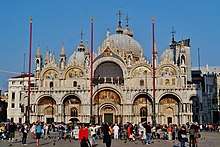 St Mark's Basilica viewed from Piazza San Marco | |
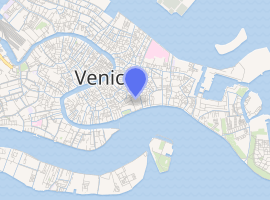
| |
| 45°26′04″N 12°20′23″E | |
| Location | Venice |
| Country | Italy |
| Denomination | Roman Catholic |
| Website | Saint Mark's Basilica |
| History | |
| Status | Cathedral, minor basilica |
| Earlier dedication | 1084, 1093, 1102 |
| Consecrated | 1117 |
| Architecture | |
| Style | Italo-Byzantine and Gothic |
| Groundbreaking | 978 |
| Completed | 1092 |
| Specifications | |
| Length | 76.5 metres (251 ft) |
| Width | 62.5 metres (205 ft) |
| Number of domes | 5 |
| Dome height (outer) | 43 metres (141 ft) |
| Dome height (inner) | 28.15 metres (92.4 ft) |
| Administration | |
| Archdiocese | Patriarchate of Venice |
The building's structure dates back to the later part of the 11th century, and the most likely influence on its architecture and design is the Hagia Sophia.[3] Much work has gone toward embellishing this, and the famous main façade has an ornamented roofline that is mostly Gothic. The gold ground mosaics that now cover almost all the upper areas of the interior took centuries to complete. In the 13th century the external height of the domes was greatly increased by hollow drums raised on a wooden framework and covered with metal; the original ones are shallower, as can be seen on the inside.[4] This change makes the domes visible from the piazza.
Many of its rich artifacts and relics were plundered from Constantinople in the Fourth Crusade in 1204 CE, including many artifacts from the Hagia Sophia.[5] The famous Madonna Nicopeia, also known as the icon of the Virgin Nicopeia, was looted from the Monastery of Stoudios and was one of the city's most precious icons, carried into battle by various Byzantine emperors. The icon was brought to Venice by Enrico Dandolo (d. 1205 CE) and the altar of the Virgin Nicopeia remains in St. Mark's Basilica until today. To the Venetians, the icon was a symbol that God had transferred His blessing from Constantinople to Venice by military conquest.[6][7][8][9]
For its opulent design, gold ground mosaics, and its status as a symbol of Venetian wealth and power, from the 11th century on the building has been known by the nickname Chiesa d'Oro (Church of gold).[10] It achieves an Oriental feeling of exoticism, has all the elements of the Venetian style of the Renaissance Art, remains unique, and essentially a product of Italian workers of all sorts.[11]
History
Earliest construction
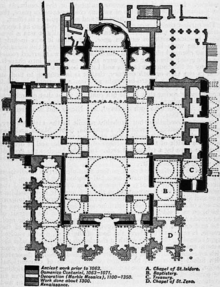
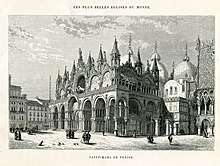
The first St Mark's was a building next to the Doge's Palace, ordered by the doge in 828. With a profusion of domes and more than 8000 sq metres of luminous mosaics, Venice's basilica is unforgettable. It was founded in the 9th century to house the corpse of St Mark after wily Venetian merchants smuggled it out of Egypt in a barrel of pork fat. When the original building burnt down, Venice rebuilt the basilica in its own cosmopolitan image St Mark's Campanile (bell tower). The church was burned in a rebellion in 976, when the populace locked Pietro IV Candiano inside to kill him, and restored or rebuilt in 978. Nothing certain is known of the form of these early churches. From perhaps 1063[12] the present basilica was constructed. The consecration is variously recorded as being in 1084–85, 1093 (the date most often taken), 1102 and 1117, probably reflecting a series of consecrations of different parts.[13] The size of the church was increased in all directions, especially to the north and south, and the wooden domes replaced by brick, which required thickening such walls as were retained.[14]
In 1094 the body considered traditionally to be that of Saint Mark was rediscovered in a pillar by Vitale Faliero, doge at the time.[15] The building also incorporates a low tower (now housing St Mark's Treasure), believed by some to have been part of the original Doge's Palace. The Pala d'Oro ordered from Constantinople was installed on the high altar in 1105.[16] In 1106 the church, and especially its mosaics, were damaged by a serious fire in that part of the city; it is not entirely clear whether any surviving mosaics in the interior predate this, though there is some 11th-century work surviving in the main porch.[17] The main features of the present structure were all in place by then, except for the narthex or porch, and the facade.
The basic shape of the church has a mixture of Italian and Byzantine features, notably "the treatment of the eastern arm as the termination of a basilican building with main apse and two side chapels rather than as an equal arm of a truly centralized structure".[18] In the first half of the 13th century the narthex and the new facade were constructed, most of the mosaics were completed and the domes were covered with second much higher domes of lead-covered wood in order to blend in with the Gothic architecture of the redesigned Doge's Palace.
As with most Venetian buildings, the main structure is built in brick, with the arches given moulded terracotta or brick decoration, with stone columns, capitals, horizontal mouldings, and some other details. The brick mostly remains in place, but covered over except in a few places.[19]
Later construction
The basic structure of the building has not been much altered. Its decoration has changed greatly over time, though the overall impression of the interior with a dazzling display of gold ground mosaics on all ceilings and upper walls remains the same. The original unadorned structure would probably have looked very different, but it is likely that gradual decoration was always intended.[20] The succeeding centuries, especially the period after the Venetian-led conquest of Constantinople in the Fourth Crusade of 1204 and the fourteenth century, all contributed to its adornment, with many elements being spolia brought in from ancient or Byzantine buildings, such as mosaics, columns, capitals, or friezes.[21] The Venetian sculptors of other capitals and friezes copied the Byzantine style so effectively that some of their work can only be distinguished with difficulty.[22] Gradually, the exterior brickwork became covered with marble cladding and carvings, some much older than the building itself,[23] such as the statue of the Four Tetrarchs (below).
The latest structural additions include the closing-off of the Baptistery and St Isidor's Chapel (1300s), the carvings on the upper facade and the Sacristy (1400s), and the closing-off of the Zen Chapel (1500s).
Function and administration
During the 13th century, the emphasis of the church's function seems to have changed from being the private chapel of the Doge to that of a "state church", with increased power for the procurators. It was the location for the great public ceremonies of the state, such as the installation and burials of Doges, though as space ran out and the demand for grander tombs increased, from the 15th century Santi Giovanni e Paolo became the usual burial place. The function of the basilica remained the same until 1807, after the end of the Venetian Republic, when the basilica finally became subject to the local bishop, the Patriarch of Venice, though from the 12th century he had had a throne there, opposite the doge's.[24] The transfer of the see was ordered by Napoleon during his period of control of Venice.[25] Before this, Venice's cathedral from 1451 was the much less grand San Pietro di Castello.
The procurators, an important organ of the Republic of Venice, were in charge of administration; their seats were the Procuratie, in St Mark's Square. All building and restoring works were directed by the protos: great architects such as Jacopo Sansovino and Baldassarre Longhena held the office. The doge himself appointed a special group of clergy led by the primero. Procurators and protos still exist and perform the same tasks for the Patriarchate.
Exterior
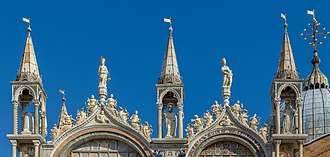
The exterior of the west facade of the basilica is divided in three registers: lower, upper, and domes. In the lower register of the façade, five round-arched portals, enveloped by polychrome marble columns, open into the narthex through bronze-fashioned doors.
The upper level of mosaics in the lunettes of the lateral ogee arches has scenes from the Life of Christ (all post-Renaissance replacements) culminating in a 19th-century replacement Last Judgment lower down over the main portal that replaced a damaged one with the same subject (during the centuries many mosaics had to be replaced inside and outside the basilica, but subjects were rarely changed).
Mosaics with scenes showing the history of the relics of Saint Mark from right to left fill the lunettes of the lateral portals; the first on the left is the only one on the façade still surviving from the 13th century. The formal subject is the Deposition of the Relics, but it is probably depicted as the crowd leaving San Marco after the ceremonial installation of a new doge. The four bronze horses are shown in their place on the façade. We can for once get a good idea of the original compositions of the mosaics from paintings and other depictions, especially Gentile Bellini's very large Procession in Piazza San Marco in the Gallerie dell'Accademia.[26]
The stone sculpture is relatively limited at the lower level, where a forest of columns and patterned marble slabs are the main emphases. It includes relatively narrow bands of Romanesque work on the portals, richly carved borders of foliage mixed with figures to the ogee arches and other elements, and large shallow relief saints between the arches. Along the roofline, by contrast, there is a line of statues, many in their own small pavilions, culminating in Saint Mark flanked by six angels in the centre, above a large gilded winged lion (his symbol, and that of Venice).
In the upper register, from the top of ogee arches, statues of Theological and Cardinal Virtues, four Warrior Saints, Constantine, Demetrius, George, Theodosius and St Mark[27] watch over the city. Above the large central window of the façade, under St Mark, the Winged Lion (his symbol) holds the book quoting “Pax Tibi Marce Evangelista Meus” (Peace to you Mark my evangelist) . In the centre of the balcony the famous bronze horses face the square.
On the railing at the southwestern corner of the balcony is an imperial porphyry head, possibly of Justinian, traditionally known as Carmagnola.
Horses of Saint Mark-Lysippos
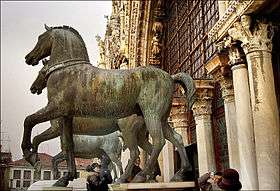
The Horses of Saint Mark were installed on the balcony above the portal of the basilica in about 1254. They date to Classical Antiquity, though their date remains a matter of debate, and presumably were originally the team pulling a quadriga chariot, probably containing an emperor. By some accounts they once adorned the Arch of Trajan.
The horses were long displayed at the Hippodrome of Constantinople, and in 1204 Doge Enrico Dandolo sent them back to Venice as part of the loot sacked from Constantinople in the Fourth Crusade.
They were taken to Paris by Napoleon in 1797 but returned to Venice in 1815. They were moved temporarily to the Palazzo Venezia in Rome during the first World War for safekeeping. During World War II, they were hidden in Praglia Abbey, a Benedictine monastery in Teolo. After a long restoration, since the 1970s the copper mercury-guilded originals have been kept in St Mark's Museum inside the basilica and the horses now on the facade of the cathedral are bronze replicas.
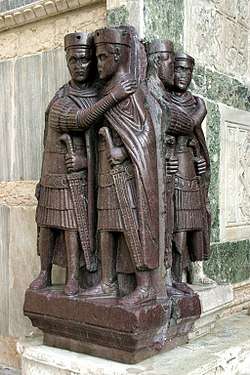
The Tetrarchs
In an attempt to stabilise the Roman Empire after the crisis of the third century, the Emperor Diocletian imposed a new Imperial office structure: a four co-emperor ruling plan called The Tetrarchy. The famous porphyry statue of the Four Tetrarchs represents the interdependence of the four rulers. It was taken from Constantinople, during the Fourth Crusade in 1204, and set into the south-west corner of the basilica (the above-mentioned low tower) at the level of the Piazza San Marco. Part of the missing foot of one of the figures was discovered in Istanbul (near the Bodrum Mosque) in the 1960s, where it is still on display, clarifying the original location of the work.
Narthex or porch
By the 13th century, the narthex or porch embraced the western arm of the basilica on the three sides; when it was first built is uncertain but was probably the 13th century. Later the southern part was closed to obtain the Baptistery (14th century) and the Zen Chapel (16th century).[28]
The narthex prepares the visitors’ eyes for the atmosphere of the gilded interior, just as the Old Testament stories represented in its 13th-century mosaic ceiling prepare them for the New Testament decoration in the interior. The main subjects are Genesis and the life of Noah, Abraham, Joseph, and Moses.[29] It has long been recognised that the compositions are very close to those of the Cotton Genesis, an important 4th- or 5th-century Greek luxury illuminated manuscript copy of the Book of Genesis, now in the British Library, though very badly damaged in a fire of 1731. About a hundred of the 359 miniatures in the manuscript are used. It is presumed that this reached Venice after the Fourth Crusade.[30]
On the wall above and at the sides of the main doorway are the Four Evangelists and saints, 11th-century mosaics, the oldest in the building, that decorated the old facade to St Mark's even before the narthex was built.[31]
Interior
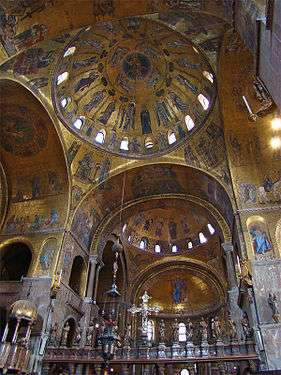
The interior is based on a Greek cross, with each arm divided into three naves with a dome of its own as well as the main dome above the crossing. The dome above the crossing and the western dome are bigger than the other three. This is based on the Church of the Holy Apostles in Constantinople.
The marble floor (12th century, but underwent many restorations) is entirely tessellated in geometric patterns and animal designs. One particular panel in the pavement shows two cocks carrying a trussed-up fox,[32] has been interpreted politically by some, as a reference to the French conquest of Milan in the Italian Wars.[33] Others see it as a sacred symbol of the faithful wish for immortality, with the victory of the cross, and "analogous to the hope of resurrection, the victory of the soul over death".[34] The techniques used were opus sectile and opus tessellatum.
The lower register of walls and pillars is completely covered with polychrome marble slabs. The transition between the lower and the upper register is delimited all around the basilica by passageways which largely substituted the former galleries.
Mosaics
Unlike most Italian churches, San Marco never made the transition to fresco wall paintings around the 13th century, and continued to add them until the 19th century. This was probably partly due to a wish to support the local Murano glass industry, which supplied the tesserae, and also to Venetian conservatism.[35]
The upper levels of the interior are completely covered with bright mosaics covering an area of about 8000 m2. The great majority use the traditional background of gold glass tesserae, creating the shimmering overall effect. Unfortunately, the Doge retained a workshop of mosaicists until the late 18th century, and in the 19th century contracted a mosaic workshop run by the Salviati glassmaking firm, and the majority of the medieval mosaics have been "restored" by removing and resetting, usually with a considerable loss of quality, so that "only about one-third of the mosaic surface can be regarded as original".[36]
The earliest surviving work, in the main porch, perhaps dates to as early as 1070, and was probably by a workshop that had left Constantinople in the mid-11th century and worked at Torcello Cathedral.[37] They are in "a fairly pure Byzantine style" but in succeeding phases of work Byzantine influence reflecting the latest style of the capital was reduced by stages, disappearing altogether by about the 1130s, after which the style was Italian in essentials, reflecting "a change from a colonial to a local art".[38] The main period of decoration was the 12th century, a period of deteriorating relations between Venice and Byzantium, but very little is known about the process or how it was affected by politics.[39]
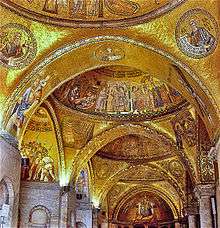

The main work on the interior mosaics was apparently complete by the 1270s, with work on the atrium continuing into the 1290s. After that the St Marks workshop seems to have been disbanded, so that when a fire in 1419 caused serious damage, the only Venetian capable of the work had just died and the Signoria of Florence had to be asked for help; they sent Paolo Uccello.[40] Initially the restorations tried to retain the medieval compositions and replicate a medieval style, but from 1509 the policy changed and further work was in contemporary styles. From the 1520s a series of Venetian painters were able to get commissions for the replacement of undamaged areas in what was considered to be superior modern style, until from 1610 a number of conservation-minded decrees attempted to restrain the process.[41]
The large and complicated programme of the decoration centres on the seated large Christ Pantocrator in the main apse (now a 15th-century recreation) above patron saints of Venice. The East dome over the high altar has a bust of Christ in the centre surrounded by standing prophets and the Virgin Mary, with the Four Evangelists in the pendentives. A large and comprehensive cycle of the Life of Christ occupies much of the roof, with usually extensive coverage for the Middle Ages of his miracles, originally shown in 29 scenes in the transepts. It includes the Ascension of Christ in the central dome and Pentecost in the west dome. The centre is an etimasia ("empty throne") with book and dove, with the twelve apostles seated round the outer rims, with flames on their heads and rays connecting them to the central throne. Below the apostles pairs of figures representing the "nations", with tituli, stand between the windows. Similar images are found in the Chludov Psalter and elsewhere.[42]
As well as the miracles the transepts contain cycles of the Life of the Virgin before and during the Infancy of Christ. As well as many saints, church fathers, virtues and angels, there are scenes from the lives of Saints Mark, Clement, Peter, and John (with many scenes in post-Renaissance versions). The west wall has a 13th-century deesis below a Last Judgement in the vault, and a huge Tree of Jesse was added to the end wall of the north transept in 1548.[43]
The origin of the iconography of the Old Testament cycle in the porch in the Cotton Genesis manuscript has been described above; similar relationships have been traced for parts of the interior mosaics, in particular with the cycle of the Life of the Virgin and Infancy of Christ sharing a common Byzantine model with a fresco cycle in the cathedral at the Mirozhsky Monastery in Pskov in Russia.[44]
As mentioned above, restorations and replacements were often necessary thereafter, or done even when not necessary, and great painters such as Paolo Uccello, Andrea del Castagno, Paolo Veronese, Jacopo Tintoretto and his son Domenico were among those who produced the designs for the mosaicists. Titian and the Padovanino prepared the cartoons for the sacristy, built in the late 15th century. Other mosaics decorate the Baptistery, the Mascoli Chapel, St Isidor Chapel and the Zen Chapel, which has scenes from the life of St Mark, perhaps from the 1270s, and among the latest work of the original programme to be done.[45]
The presbytery
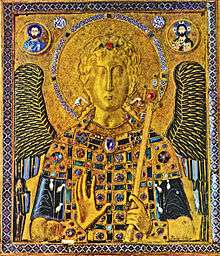
The eastern arm has a raised presbytery with a crypt beneath. The presbytery is separated by an altar screen formed by eight red marble columns crowned with a high Crucifix and statues by Pier Paolo and Jacobello Dalle Masegne, masterpiece of Gothic sculpture (late 14th century). Behind the screen, marble banisters with Sansovino's bronze statues of the Evangelists and Paliari's of the Four Doctors mark the access to the high altar, which contains St Mark's relics. Above the high altar is a canopy (“ciborium”) on columns decorated with fine reliefs. The altarpiece is the famous Pala d'Oro, a masterpiece of Byzantine craftsmanship, originally designed for an antependium. This masterpiece incorporates 1,300 pearls, 300 sapphires, 300 emeralds, and 400 garnets. They are all original and highly polished, unfaceted gems. The original altar frontal is now in the treasury. The choir stalls are embellished with inlay by Fra Sebastiano Schiavone, and above them on both sides are three reliefs by Sansovino.
Behind the presbytery are the sacristy and a 15th-century church consecrated to St Theodore (the first patron saint of Venice) where is displayed a painting (Child's Adoration) by Giovanni Battista Tiepolo.
The treasury
The treasury contains what is now a unique collection of Byzantine portable objects in metalwork, enamel and hardstone carving, most looted from Constantinople after the Fourth Crusade (although there was a serious fire in the treasury in 1231), with probably a new influx after the "Franks" were expelled in 1261.[46] Thereafter most objects were made locally, though there are also important Islamic works, especially in rock crystal, and some from Northern Europe. Selections have toured internationally.
The treasury is in the basilica until today; the [47] objects in an inventory ordered by the Austrians in 1816, many in materials that could not be recycled for cash.[48] The group of Byzantine hardstone vessels in various semi-precious stones is by the most important to survive.[49] A glass situla or bucket carved with Bacchic figures been dated to either the 4th or 7th centuries.[50]
The 6th-century "throne-reliquary" in rather crudely carved alabaster, the Sedia di San Marco, was moved from the high altar to the Treasury in 1534. It would only fit a bishop with a slight figure, and has a large compartment for relics below the seat. It may have functioned as a "throne-lectern" or resting place for a gospel book, making actual the hetoimasia ("empty throne") images with open books that are found in art of the period.[51]
The treasury "now houses the best single collection of Byzantine metalwork, and particularly of enameling, that survives", including two imperial chalices of antique sardonyx with Byzantine gold and enamel mounts, marked "Romanos", the name of four emperors.[52]
Right transept
On the right of the screen is the platform from which the newly elected doge appeared. In the left aisle are St Clement’s chapel and the Holy Host altar. Here is the pillar where St Mark’s relics were rediscovered in 1094, as depicted in the interesting mosaics of the right aisle (where the entrance to St Mark’s Treasure is)..
Left transept
On the left of the screen is the platform for readings from Scripture; on the right aisle are St Peter’s chapel and the Madonna Nicopeia, a venerated Byzantine icon. On the northern side are St Isidor’s chapel and the Mascoli chapel.
Music
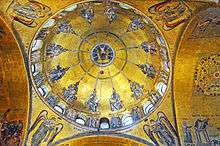
The spacious interior of the building with its multiple choir lofts was the inspiration for the development of a Venetian polychoral style among the composers appointed maestro di cappella at the choir of St Mark's. The style was first developed by a foreigner, Adrian Willaert, and was continued by Italian organists and composers: Andrea Gabrieli, his nephew Giovanni Gabrieli, and Claudio Monteverdi. Their music took advantage of the spacious architecture and led to the development of polychoral and antiphonal textures. An example of this technique is found in In Ecclesiis by Giovanni Gabrieli.
In scientific discourse
One of the most well-known and widely cited[53] papers in biology is "The Spandrels of San Marco and the Panglossian Paradigm: A Critique of the Adaptationist Programme".[54] It is based on an analogy between the beautifully decorated spandrels spaced around the domes in the basilica, which sit on four arches (technically, the structures are pendentives rather than spandrels), and various biological traits and features. The authors, Stephen Jay Gould and Richard Lewontin, argue that the spandrels are the inevitable spaces that exist when a dome is placed above arches rather than design elements and that many biological traits are similarly the side effects of functional traits rather than adaptive traits in themselves.
See also
Notes
- Demus, 1
- "Basilica di San Marco". Archived from the original on 5 March 2015. Retrieved 10 February 2016.
- "Basilica di San Marco". www.genegillminiatures.com. Retrieved 29 July 2020.
- Howard, 19-21; [[:File:A history of architecture in Italy from the time of Constantine to the dawn of the renaissance (1901) (14597449730).jpg|Elevation drawing showing the dome structure
- "HISTORY OF HAGIA SOPHIA CHURCH IN CONSTANTINOPLE". Greek City Times. Retrieved 29 July 2020.
- Barcham, William L.; Tiepolo, Giovanni Battista (1989). The Religious Paintings of Giambattista Tiepolo: Piety and Tradition in Eighteenth-century Venice. Clarendon Press. p. 108. ISBN 978-0-19-817501-8. Retrieved 29 July 2020.
- Belting, Hans (1994). Likeness and Presence: A History of the Image Before the Era of Art. University of Chicago Press. p. 204. ISBN 978-0-226-04215-2. Retrieved 29 July 2020.
- "San Mark's Nicopeia loot from Constantinople 1204 - Hagia Sophia History". www.pallasweb.com. Retrieved 29 July 2020.
- "Madonna Nicopeia". Save Venice Inc. | Dedicated to preserving the artistic heritage of Venice. Retrieved 29 July 2020.
- Fodor's Italy 2011. Random House Digital, Inc. 31 May 2011. p. 190. ISBN 9780307928528.
- Howard, 28
- "Navigation path". www.basilicasanmarco.it. Archived from the original on 5 March 2015. Retrieved 10 February 2016.
- Demus, 3
- Howard, 19-22
- "Recovery". basilicasanmarco.it (in Italian). Archived from the original on 4 October 2013. Retrieved 28 July 2013.
- Demus, 3
- Demus, 5, 15-19
- Demus, 5
- Howard, 24
- Howard, 27
- Demus, 6; Howard, 25
- Howard, 26
- Howard, 26-27
- Demus, 1-2
- Buckton, 68
- Demus, 183-187
- "The Gothic Crowning". basilicasanmarco.it. Retrieved 20 August 2012.
- Demus, 127
- Demus, Chapter 18
- Demus, 155-157
- Demus, 15-19
- "Venice Basilica San Marco interior 07 Mural 2 cocks carrying a fox". Flickr. May 1996. Retrieved 22 July 2012.
- Sanderson, David; Chambers, Jennifer; Fletcher, Brian S. Pullan (2001). Venice: A Documentary History, 1450-1630. Renaissance Society of America. p. 397. ISBN 9780802084248.
- The Theme of Cockfighting in Burgundian Romanesque Sculpture, Ilene H. Forsyth – Speculum: A Journal of Medieval Studies Vol. 53, No. 2 (Apr., 1978), pp. 252–282 – Publisher: Medieval Academy of America
- Howard, 16
- Demus, 6-11, 10 quoted
- Demus, 15-19
- Demus, 37-38, 189 (quoted)
- Demus, 5-6
- Demus, 6-7
- Demus, 7-9
- Demus, 55-57, and plate 13; also Parani, 196. See here for further details]
- Demus, 10-11 for summary, full coverage in later chapters.
- Dodwell, 186
- Demus, 179-182
- Buckton, 65-66, 73-75
- Encyclopaedia Britannica
- Buckton, 67
- Buckton, 73-75
- Buckton, 77-78
- Buckton, 98-105
- Buckton, 105
- "Google Scholar". Scholar.google.ca. Retrieved 22 July 2012.
- Gould, S.J.; Lewontin, R.C. (1979). "The spandrels of San Marco and the Panglossian paradigm: A critique of the adaptationist programme". Proceedings of the Royal Society of London B. 205 (1161): 581–598. doi:10.1098/rspb.1979.0086. PMID 42062.
References
- Buckton, David, et al., The Treasury of San Marco Venice, 1984, Metropolitan Museum of Art, (fully available online or as PDF from the MMA)
- Demus, Otto. The Mosaic Decoration of San Marco Venice (1 volume version, edited by Herbert L. Kessler), University of Chicago Press, 1988, ISBN 0226142922
- Dodwell, C.R.; The Pictorial arts of the West, 800-1200, 1993, Yale UP, ISBN 0300064934
- Guida D'Italia del Touring Club Italiano–Venezia (in Italian) (3rd ed.). Milano: Touring Club Italiano. 2007. ISBN 978-8836543472.
- Howard, Deborah (2004), The Architectural History of Venice (2nd edn), Yale UP, ISBN 978-0300090291
- St. Marco (Video). DjustD. 15 June 2010. Archived from the original on 25 December 2012.
- Vianello, Sabina (1993). Le Chiese Di Venezia (in Italian). Milano: Electa. ISBN 978-8843540488.
- Vio, Ettore (2001). Lo Splendore Di San Marco (in Italian). Rimini: Idea Libri. ISBN 978-8870827279.
External links
| Wikimedia Commons has media related to St Mark's Basilica. |
- Official website
- St. Mark's Museum
- Satellite image from Google Maps
- The Nicopeia Icon of San Marco
- San Marco, Byzantium, and the Myths of Venice" PDF of parts (71 pages) of book, Dumbarton Oaks Byzantine Symposia and Colloquia, "Introduction" and "Refashioning Byzantium in Venice, ca. 1200–1400"